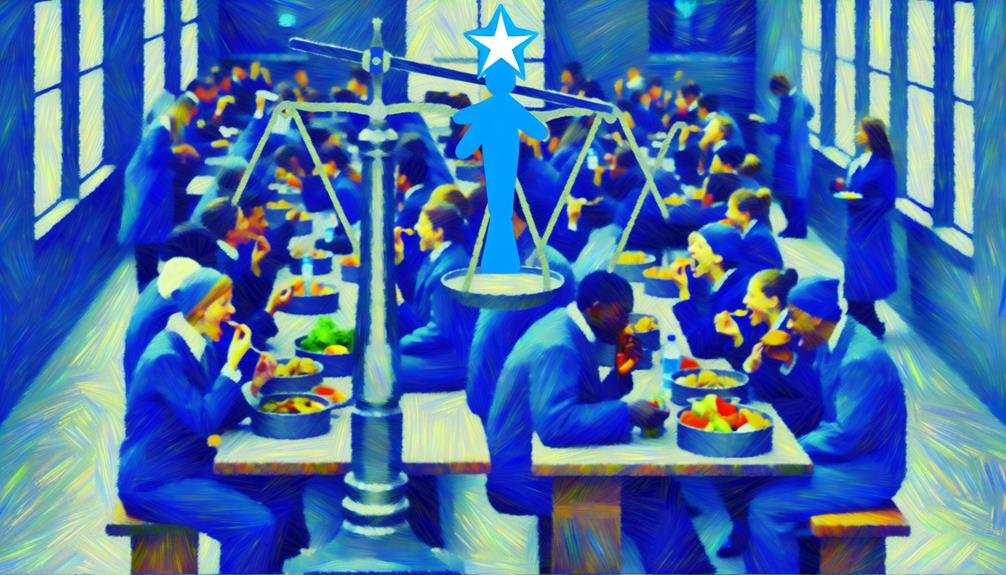Junk food in schools is like a tempting treasure chest filled with both delicious treats and sneaky risks. Imagine munching on those crispy fries and gooey cheeseburgers – so satisfying, right? But hold on tight because while they taste like pure heaven, they could also bring along a storm of health issues like obesity and low energy levels. It’s like a rollercoaster ride – thrilling at first, but can leave you feeling dizzy in the end. Interested to explore more about this juicy topic? Keep going to uncover all the secrets behind junk food in schools! 🍔🥤
Takeaways
- Pros: Easy access for students, quick snack option.
- Cons: Health risks like obesity and diabetes.
- Pros: High profit margin for schools.
- Cons: Negative impact on academic performance.
- Pros: Popular among students, appealing taste.
Convenience and Accessibility
The importance and guarantee of junk food in schools have raised concerns among educators and health professionals alike. With vending machines filled with sugary drinks and salty snacks just a few steps away from classrooms, it’s no wonder that students often opt for these quick and tasty options. While it may seem like a harmless treat at first, the regular consumption of junk food can have serious consequences on students’ health and academic performance.
Imagine this: you’re rushing to class, stomach grumbling, and the only thing in sight is a vending machine stocked with tempting treats. It’s so easy to grab a bag of chips or a sugary soda to satisfy your hunger pangs. But what many students don’t realize is that these convenient snacks are often packed with unhealthy fats, sugars, and additives that can lead to weight gain, fatigue, and even long-term health issues.
In the battle between convenience and health, it’s vital to strike a balance that prioritizes nutritious options while still offering students the occasional treat. By promoting healthier alternatives like fruits, nuts, and whole-grain snacks, schools can make sure that students have access to convenient foods that fuel their bodies and minds for success.
Impact on Children’s Health
Let’s talk about the impact that junk food in schools can have on our health, specifically on our children’s well-being.
The health risks associated with consuming high amounts of junk food, such as obesity, diabetes, and heart disease, are well-documented.
Additionally, these foods often lack essential nutrients, leading to nutritional deficiencies that can hinder children’s growth and development.
Health Risks
Frequently consuming junk food in schools can have detrimental effects on children’s overall health and well-being. The lure of sugary drinks, greasy fries, and tempting snacks can lead to a host of health risks for students. These foods often lack essential nutrients, leading to poor concentration, low energy levels, and weight gain. Imagine trying to solve a math problem with a foggy brain after a lunch filled with only chips and soda – not an ideal scenario, right?
Moreover, regularly indulging in junk food can increase the risk of developing chronic conditions such as obesity, type 2 diabetes, and heart disease at a young age. It’s like setting off on a journey with a broken compass; these health risks can steer children off course from a vibrant and active life.
We want our young learners to be full of energy, ready to take on challenges, and enjoy all the fun that childhood has to offer. By being mindful of the health risks associated with junk food, we can pave the way for a healthier and happier future for our students.
Nutritional Deficiencies
Consuming junk food in schools not only poses health risks for students but also contributes greatly to nutritional deficiencies that can impact children’s overall health. When kids indulge in sugary snacks, greasy fries, and processed foods regularly, they miss out on essential nutrients crucial for their growth and development.
Imagine this: a student’s body is like a garden that needs a variety of fruits, vegetables, whole grains, and lean proteins to flourish. However, feeding it only with junk food is like watering those plants with soda – it just won’t thrive!
These nutritional deficiencies can lead to a host of health issues, from weakened immune systems to poor concentration in class. Envision trying to solve a math problem on an empty stomach – not the best scenario, right? Plus, lacking important vitamins and minerals can affect children’s energy levels, making them feel sluggish and tired throughout the day.
It’s like running a race with shoes that are two sizes too big – you’re just not going to perform at your best! So, let’s nourish our bodies with the good stuff, giving ourselves the nutrients we need to shine bright like the stars we are!
Influence on Academic Performance

Let’s ponder on this thought-provoking idea – could our academic performance be connected to the snacks we choose?
Imagine this: could that sugary soda or greasy chips impact our focus during class? Perhaps choosing a balanced meal could be the secret formula for keeping our energy levels up and our grades soaring high!
Let’s delve into how our snack choices might just reveal the key to unleashing our academic success.
Academic Focus and Junk Food
Numerous studies have suggested a significant correlation between the consumption of junk food in schools and a decline in academic performance among students. It’s like trying to study for a math test while your brain is floating in a sea of soda and chips – not the most conducive environment for acing that exam!
Think about it: when you fuel up on sugary snacks and greasy treats, your brain might experience a temporary high, but soon enough, it crashes like a student trying to pull an all-nighter on energy drinks.
Imagine trying to focus on Shakespeare’s intricate prose or solving complex algebraic equations when your body is busy processing a mountain of fries. It’s like asking a race car to run on cheap, low-quality fuel – it might sputter and stall when you need it to race at top speed.
Energy Levels and Grades
Imagine this: a student yawning through math class, struggling to keep their eyes open after lunch. Now, envision another student, wide awake, enthusiastically participating in discussions and acing their assignments. That’s the energy difference we’re talking about here!
When students consume junk food in schools, their energy levels can fluctuate like a rollercoaster. Foods high in sugar and fat might give a temporary boost, but soon after, they can crash, leaving students feeling sluggish and unfocused.
This rollercoaster effect can directly impact their ability to concentrate in class, retain information, and perform well on tests. On the flip side, students who fuel their bodies with nutritious foods experience more sustained energy levels, enabling them to stay alert, engaged, and on top of their academic game.
Popularity Among Students
A significant portion of students demonstrates a strong preference for junk food over healthier options in school cafeterias. It’s no secret that the allure of crispy fries, cheesy pizzas, and sugary sodas often triumphs over the humble salad or fruit cup. Let’s take a closer look at just how popular junk food is among students:
| Junk Food Item | Frequency of Consumption | Typical Reactions |
|---|---|---|
| Cheeseburger | High | Excited and Satisfied |
| French Fries | Very High | Happy and Craving More |
| Chocolate Milk | Moderate | Sweet Tooth Delight |
As we can see from the table, junk food like cheeseburgers and French fries reign supreme in the school cafeteria scene. The aroma of sizzling fries or the gooey cheese dripping from a burger can easily make any student’s mouth water. Chocolate milk, a classic favorite, also holds its ground as a go-to beverage choice. It’s no wonder why these items continue to fly off the trays and into the hungry hands of students every lunchtime!
Financial Considerations for Schools

Considering the budget constraints faced by educational institutions, evaluating the financial implications of offering junk food in schools is imperative. While it may seem like adding sugary snacks and sodas to the cafeteria menu can bring in extra cash, the reality is a bit more complex.
Yes, junk food often comes with a higher profit margin compared to healthier options, but the long-term costs can add up. Schools may end up spending more on healthcare for students dealing with obesity-related issues, absenteeism due to health problems, and even academic performance may suffer.
Moreover, stocking up on junk food means less room for nutritious meals that provide students with the energy they need to focus and learn effectively. So, in the end, what might seem like a quick financial boost could actually lead to greater expenses down the line.
Finding a balance between financial considerations and the well-being of students is key when deciding whether to offer junk food in schools.
Role in Dietary Education
Understanding the impact of junk food in schools extends beyond financial considerations to its pivotal role in dietary education for students. Junk food, with its high sugar, salt, and fat content, often dominates school cafeterias and vending machines. This prevalence presents a unique opportunity to educate students about making healthy food choices.
Here are three ways junk food can play a role in dietary education:
- Teachable Moments: Junk food consumption can be used as a starting point for discussions on nutrition, ingredients, and the importance of balanced meals.
- Label Reading: Analyzing the nutritional content of popular junk food items can teach students how to read labels and make informed decisions about their food choices.
- Alternative Options: By introducing healthier versions of popular junk food items or offering nutritious alternatives, schools can encourage students to explore new flavors and understand that healthy food can be delicious too.
Potential Long-Term Health Effects

Visualize this: indulging in junk food in schools can have detrimental long-term health effects on students. While enjoying the occasional treat can be enjoyable and tasty, a diet high in junk food can lead to serious health issues down the road.
Imagine a student snacking on greasy fries at lunch, unaware of the impact it could have on their future well-being. Over time, consistently consuming foods high in sugar, salt, and unhealthy fats can pave the way for obesity, heart disease, diabetes, and other chronic conditions. It’s like planting seeds of poor health that may sprout into problems later on.
Furthermore, junk food lacks essential nutrients that growing bodies and minds need to thrive. Envision trying to build a sturdy house without the right materials – it just wouldn’t work! Similarly, relying heavily on junk food can hinder proper growth and development in students, affecting their overall health in the long run.
Frequently Asked Questions
Are There Any Cultural or Regional Differences in Junk Food Preferences Among Students?
Cultural and regional variations influence students’ junk food preferences. Factors like traditional cuisines, local food availability, and marketing trends play a role. Understanding these differences can help tailor school food options to better meet students’ needs.
How Do Junk Food Advertising Campaigns Affect Students’ Food Choices?
Junk food advertising campaigns can greatly impact students’ food choices by promoting unhealthy options as desirable and convenient. These campaigns may shape preferences, increase consumption of low-nutrient foods, and contribute to the prevalence of childhood obesity.
What Role Do Parents Play in Monitoring and Regulating Junk Food Consumption?
Parents play an essential role in monitoring and regulating their children’s junk food consumption. By setting healthy eating habits, providing nutritious options, and educating on the importance of balanced nutrition, parents can positively impact their children’s overall health and well-being.
Can Junk Food Consumption in Schools Contribute to the Development of Eating Disorders?
Consumption of junk food in schools can potentially contribute to the development of eating disorders among students. Poor nutritional choices, lack of education on healthy eating habits, and constant availability of unhealthy options may all play a role.
Are There Any Initiatives or Programs Aimed at Reducing Junk Food Consumption in Schools?
Various initiatives and programs aim to reduce junk food consumption in schools by promoting healthier options, implementing nutrition education, and restricting the availability of unhealthy snacks. These efforts prioritize student well-being and encourage positive dietary habits.
Conclusion
To sum up, the debate over junk food in schools is a complex one with valid arguments on both sides. While it may offer convenience and appeal to students, the negative impact on health and academic performance cannot be ignored.
Schools must carefully consider the pros and cons before deciding whether or not to offer junk food options. Ultimately, the well-being of students should be the top priority in this important discussion.

